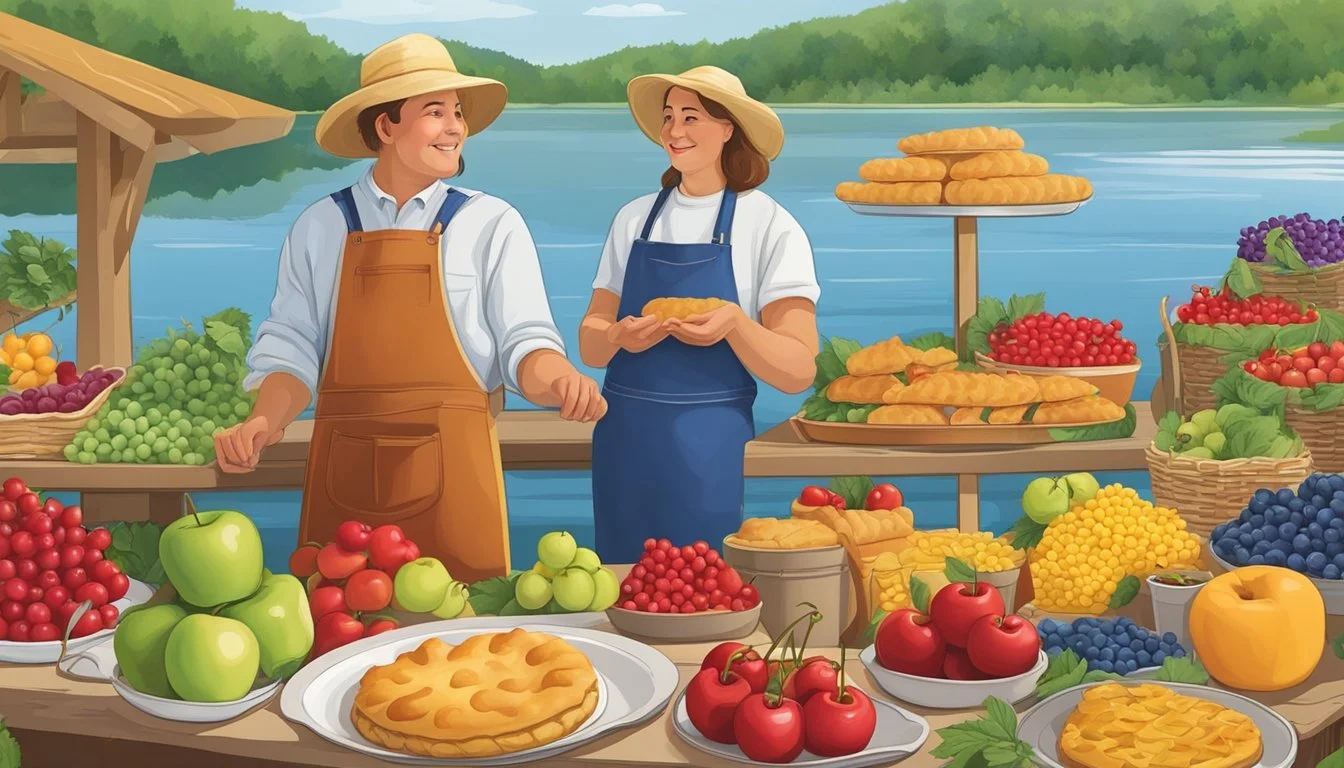What Food is Michigan Known for?
Unveiling Iconic State Delicacies
Michigan's culinary landscape is as diverse and rich as its lakes and cultural history, offering a variety of iconic foods that have become synonymous with the Great Lakes State. With an emphasis on hearty, comforting dishes that reflect its regional resources and immigrant influences, Michigan cuisine has carved out a unique niche in America's gastronomic map. From the Upper Peninsula to the bustling cities downstate, each region contributes its signature flavors to what can be collectively considered Michigan food.
One cannot mention Michigan's food without giving a nod to the pasty, a hand-held pie originally brought over by Cornish miners and adopted heartily by the residents of the Upper Peninsula. Traditionally filled with meat and potatoes, (What wine goes well with potatoes?) pasties have expanded in variety to include chicken, vegetables, and even pizza fillings. Similarly, Detroit's claim to the Coney dog, a hot dog smothered in a beanless chili sauce, is a reflection of Michigan's love for comfort foods which serve as both a quick meal and a piece of culinary heritage.
Beneath the surface of these popular dishes lies a bounty of locally-sourced ingredients from Michigan's farms and the surrounding Great Lakes, contributing to the state's distinctive food offerings. Cherries (how long do cherries last?)from Traverse City, apples from countless orchards, and fresh fish plucked from the cold lake waters are just a few examples of the natural produce that shape Michigan's food scene. This connection between the local fare and the environment underlines the integral role that regional ingredients play in defining Michigan's cuisine.
Iconic Foods of Michigan
Michigan offers a rich tapestry of unique foods that have become synonymous with its regional cuisine. From the bustling streets of Detroit to the shores of the Great Lakes, these iconic dishes are deeply ingrained in Michigan's culinary identity.
Coney Dogs
Michigan's Coney Dogs are a variant of the hot dog that is especially popular in the Detroit area. Coney Dogs consist of a beef hot dog, nestled in a soft bun, and topped with a savory meat chili, chopped onions, and a stripe of yellow mustard. Though variations exist, the traditional Coney Dog is known for its balance of flavors and textures.
Pasties
Pasties are a hearty hand-held pie, originally brought to Michigan by Cornish miners. These savory pastries are stuffed with a mixture of meats and vegetables—typically beef, potatoes, and onions—and encased in a flaky crust. They are a comfort food staple in the Upper Peninsula, epitomizing Michigan's regional fare.
Detroit-Style Pizza
Detroit-Style Pizza is distinguishable by its thick, fluffy crust, which is crispy and caramelized on the edges due to the cheese that's spread to the very edges of the pan. This square-cut pizza is layered with toppings and cheese, then finished with stripes of sauce on top. The crust and toppings strike a harmonious balance, making the Detroit-style pizza a beloved choice among locals and visitors alike.
Famous Michigan Snacks and Sweets
Michigan's snack scene is epitomized by iconic treats like handcrafted potato chips, indulgent fudge, and orchard-fresh cherries. These signature sweets and snacks are not mere foods; they're woven into the state’s culinary identity.
Better Made Potato Chips
Better Made Potato Chips have been a Detroit staple since 1930. Crafted using locally sourced potatoes and a time-honored production process, they offer a crunchy and flavorful experience. The brand has a loyal following and offers a variety of flavors, including the traditional, seasoned, and limited edition releases.
Mackinac Island Fudge
Mackinac Island Fudge is a creamy confectionery that has made Mackinac Island famous. The fudge shops on the island have been serving this sweet delight since the late 19th century. Visitors often watch the fudge being made by hand, enjoying the traditional recipes that feature rich chocolate, nuts (how long do nuts last?), and other additions.
Traverse City Cherries
Traverse City is renowned as the cherry capital of the world, and the local cherries are celebrated in many forms. From fresh, plump cherries to the coveted cherry pie, made with tart cherries that burst with flavor, these fruits are central to the region’s agricultural pride. The annual National Cherry Festival is a testament to their importance, attracting visitors globally.
Local Beverages
Michigan offers a distinct array of beverages that reflect its local culture and resources. This section explores the state's cherished sodas and its vibrant beer and wine industries.
Vernors
Vernors is a beloved ginger ale synonymous with Michigan's beverage identity. Originally created in Detroit, it is known for its distinctive, bold flavor and effervescence. It holds the title of being one of America's oldest soft drinks still in production.
Michigan Beers
Michigan's breweries excel in crafting a diverse range of beers:
Founders and Bell's Brewery are two of the largest and most recognized names, known for their innovation and flavorful profiles.
The microbrew scene is robust with numerous smaller breweries such as Short's Brewing Company, offering unique and locally-inspired brews.
From classic lagers to experimental ales, Michigan beers have earned a national reputation for quality and creativity.
Michigan Wines
The state's wineries are celebrated for producing wines that capture the unique terroir of the Michigan vineyards:
The primary grape varieties include Riesling, Chardonnay, and Pinot Noir, with many vineyards situated along the scenic Lake Michigan Shore and Old Mission Peninsula.
Michigan wines have garnered respect for their quality and have received multiple awards in national and international competitions.
The region's cooler climate mirrors that of renowned European wine regions, contributing to the distinctive characteristics of Michigan wines.
Agricultural Produce
Michigan's agricultural sector is renowned for its diversity, producing a wide array of fruits and vegetables. Among its most celebrated produce are apples, blueberries (how long do blueberries last?), sweet corn, and potatoes, each lending to the state's rich agricultural tapestry.
Michigan Apples
Michigan ranks third in the nation for apple production. The state grows a variety of apples, including the popular Honeycrisp and McIntosh. Apple orchards occupy substantial acreage and contribute significantly to the local economy, with autumn apple-picking becoming a cherished tradition for many families and tourists.
Michigan Blueberries
This state is one of the nation's leading producers of high-quality blueberries. Michigan blueberries are harvested from both cultivated and wild plants. The blueberry season runs from late July to early September, offering peak freshness and flavor in every berry.
Sweet Corn and Potatoes
Sweet corn is a summer staple in Michigan, with harvests providing fresh produce for both local consumption and export. The state’s climate and soil are well-suited for corn, leading to flavorful and tender crops.
Michigan is also notable for its production of potatoes. The state's potato varieties range from russets to reds and are an important part of Michigan's agricultural output, utilized in both fresh markets and processing industries.
Regional Specialties
Michigan's culinary landscape is as diverse as its terrain, with each region offering distinct flavors and dishes that capture the essence of the area's cultural and agricultural heritage.
Upper Peninsula Delights
In the Upper Peninsula, locally caught lake whitefish and whitefish play a central role in regional cuisine. They often feature smoked or grilled and served in local eateries, representing a connection to the Great Lakes' bounty. The area also boasts a substantial game industry, with dishes featuring pork and venison reflecting the hunting traditions of the region. Berries, including thimbleberries, are harvested both wild and from farms, adding sweet and tart profiles to the Upper Peninsula's gastronomic identity.
Grand Rapids Favorites
Grand Rapids, known for its vibrant food scene, brings a few unique items to Michigan's table. The olive burger is a local specialty, a hamburger topped with a tangy olive sauce that pairs the fruitiness of green olives with a creamy mayo base. Grand Rapids also participates robustly in the state's love for berry crops, integrating these fruits into desserts, jams, and craft beverages, celebrating Michigan's lush agricultural produce.
Ann Arbor Staples
Ann Arbor's culinary offerings reflect its eclectic and health-conscious community. The chipati is an Ann Arbor innovation, a salad-filled pita bread that has become a staple in local diets. This creation is a testament to the city's inventive spirit, combining convenience with a desire for fresh, wholesome ingredients. Additionally, Ann Arbor enjoys the fruits of Michigan's fields with farm-to-table restaurants featuring seasonal menus that often include dishes made with locally sourced pork and venison, staying true to the state's rich hunting traditions.
Ethnic and Cultural Influences
Michigan's culinary landscape is a reflection of its rich cultural tapestry, with influences stemming from various European communities. These communities have left a lasting impact on the state's food scene, bringing with them traditional recipes that have since become Michigan staples.
Polish Cuisine
In areas like Hamtramck, a city known for its Polish majority, traditional Polish dishes are abundant. Pączki, a type of doughnut filled with fruit or cream, is especially popular, with Pączki Day (similar to Fat Tuesday) being widely celebrated. Pierogi, stuffed dumplings, often filled with potatoes, cheese, or sauerkraut (how long does sauerkraut last?), have also made a home in Michigan's Polish-American communities.
German Cuisine
Michigan's German influence is perhaps best exemplified by the city of Frankenmuth, which is known for its Bavarian-style architecture and Frankenmuth chicken—a crispy, well-seasoned specialty served family-style. This community also brings a taste of German sausage and sauerkraut, reflecting the hearty, rustic flavors traditional to German cuisine (What Wine Pairs Perfectly With German Cuisine).
Italian Influences
The Italian community has contributed richly with dishes featuring tomato-based sauces (What wine goes well with tomato-based sauces?) and pepperoni, staples of Italian-American cuisine. This influence is evident in the popularity of pizza in Michigan, particularly Detroit-style pizza, characterized by its thick, rectangular crust, a crunchy exterior, and a soft interior. Italian-inspired dishes in Michigan often feature bold flavors and generous portions, with pasta and pizza being perennial favorites.
Food Festivals and Events
Michigan's culinary scene is seasoned with a variety of food festivals celebrating its rich agricultural heritage and diverse food offerings. Notably, the National Cherry Festival stands out as a premier event. Held in Traverse City, known as the Cherry Capital of the World, this festival is steeped in more than 90 years of tradition, typically taking place in July. Visitors can expect a plethora of cherry-related food stalls offering everything from pies to preserves.
Food Festivals in Michigan:
National Cherry Festival: Traverse City's homage to its cherry predominance, featuring live music and parades alongside cherry-infused delights.
Other Statewide Festivals: Numerous other events focus on fruits like apples and blueberries, plus unique regional offerings such as the Trenary toast.
These festivals not only underscore Michigan's love for cherries and other fruits but also encapsulate the spirit of local communities and their support for small businesses. Each event is threaded with activities designed to engage visitors of all ages, creating unforgettable experiences enveloped in Michigan's authentic flavors.
Festival Notable Features National Cherry Festival Live music, parades, cherry foods Other Food Festivals Support for local businesses, family-friendly activities
The festivals offer a true taste of Michigan, from its famous fruits to artisanal eats, underscoring the pride they hold in their local cuisine and the joy of sharing it with others.
Historical Context of Michigan Cuisine
Michigan's culinary heritage is a rich tapestry woven from its diverse ethnic communities and the local bounty of its farms and lakes. The state's cuisine reflects the influences of various immigrant groups who have shaped its food landscape over time, primarily through hearty, savoury dishes that catered to the robust working-class.
Cornish and French Influences
Cornish Miners introduced the pasty, a savoury hand-held pie that initially served as a convenient lunch for miners. The pasty typically contains meat and vegetables, snugly encased in a sturdy wheat crust, reflecting the miners' need for a filling meal on the go. Over time, this dish has become a staple in Michigan's Upper Peninsula.
French settlers contributed rustic, hearty dishes that utilized local ingredients, focusing on both flavour and sustenance. One can see the French influence in the use of techniques like braising and baking, as well as the incorporation of local produce and game into meals. Their use of traditional ovens laid the groundwork for a variety of baked goods and dishes that are now quintessential to Michigan.
Greek and Italian Communities
Greek immigrants influenced Michigan cuisine by introducing a range of dishes that have since been embraced by the wider population. In particular, they brought a variety of savoury and sweet pastries, integrating local ingredients like wheat into their traditional recipes. These contributions have enriched Michigan's food scene, offering a taste of the Mediterranean.
Italian communities in Michigan were instrumental in popularizing pasta, pizza, and other Italian specialties, adjusting their rich, tomato-based recipes to the local palate and available ingredients. Their cuisine was particularly celebrated for providing comfort and warmth during the long Michigan winters, becoming a mainstay in the state's culinary offerings.







